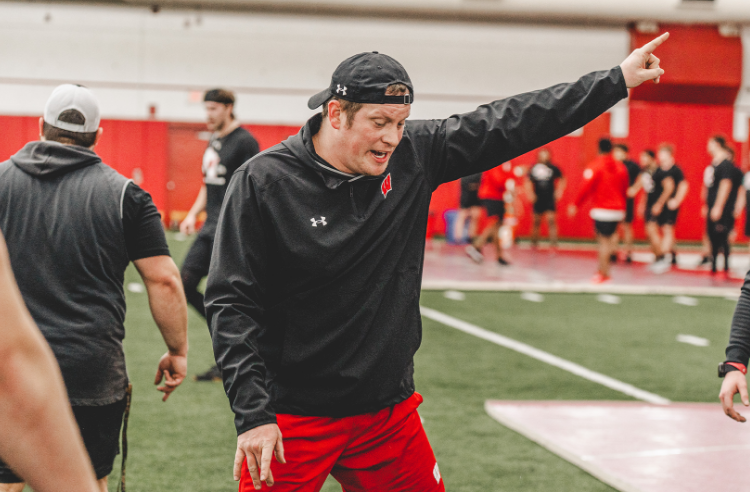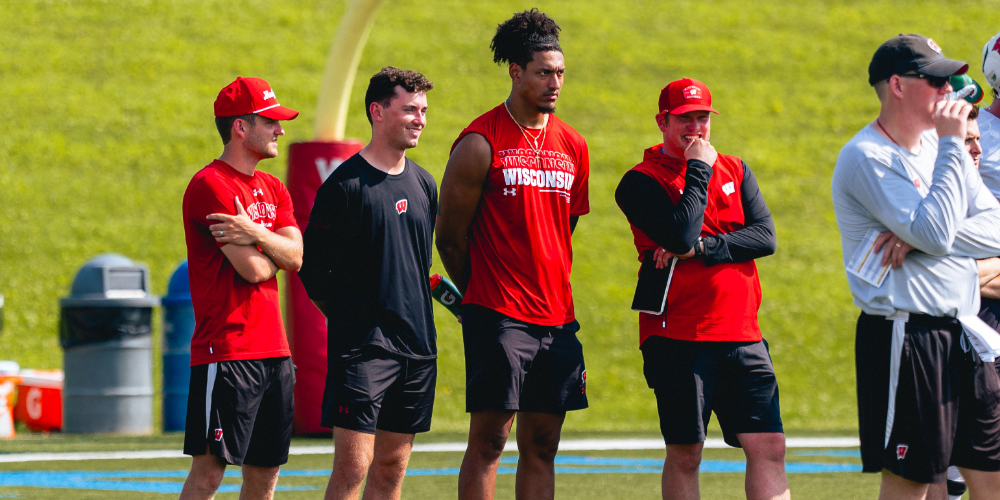Editor’s note: In conjunction with Wisconsin’s football season opener, all new content this week is free to view at Badger Connect. Please consider becoming a member for every article and weekly giveaways.
MADISON, Wis. — There was a natural rhythm and synergy within Wisconsin’s football recruiting office between two colleagues who could trade good-natured barbs and finish each other’s sentences. To mention director of recruiting Pat Lambert meant referencing director of player personnel Max Stienecker. Pat and Max. Max and Pat.
They had arrived at Wisconsin late in 2022 as two of head coach Luke Fickell’s first hires from Cincinnati, energetic personalities whose task in Madison was clear: Replicate what they did at Cincinnati — where they helped the Bearcats lead the American Athletic Conference in recruiting their last three years — but on a bigger and more ambitious scale.
Lambert and Stienecker voluntarily agreed to share the same room on the eighth floor of the football building, all the better to increase communication and the flow of ideas as they essentially divided responsibilities evenly. And for two years, the duo spearheaded an uptick in high school recruiting while selling optimism and excitement. Wisconsin finished with consecutive top-30 high school classes in Fickell’s first two full recruiting cycles, which featured 18 247Sports Composite four-star players.
Much has changed at Wisconsin and across college football, causing a re-evaluation and expansion in how the Badgers approach their recruiting department. Stienecker left in early February to become executive director of player personnel at USC. Marcus Sedberry, a deputy athletic director at Wisconsin, was hired as the program’s first general manager two weeks later. Ethan Russo, previously the director of player personnel at North Texas, arrived at the beginning of April to occupy the same role at Wisconsin.
“With Max leaving, we knew each other so well, we had a routine and operation that we felt like it was going really well,” Lambert said. “Obviously, you need that to transition onto the football field, which we feel like it will with some of these younger guys hopefully getting in the two-deep and continuing to make plays and develop.
“But I think getting Ethan in here, seeing it from a different lens and helping to continue to evolve and grow, that’s the biggest thing. This landscape of recruiting personnel, it’s ever-evolving. Being able to sit back and maybe even reset on some things has actually been good of late.”
Start with the organizational and structural differences. Wisconsin had five full-time recruiting department staffers when Lambert and Stienecker arrived. Lambert said that number has ballooned to 10 full-timers, not including Sedberry’s role.
Lambert is still heavily involved in establishing recruitment strategy and communication with top prospects but is now in more of an oversight role with a greater direct line to Fickell as the Badgers have added more assistant directors of player personnel to help recruit specific positions. Previously, Lambert was considered the general manager of skill positions, which meant he handled evaluations of cornerbacks, safeties and wide receivers.
Stienecker was the GM of big skill, which put him in charge of running backs, tight ends and linebackers. Casey Rabach, then a recruiting assistant, handled offensive and defensive linemen as well as quarterbacks. Rabach became an assistant offensive line coach for the Badgers last season. Now, Wisconsin has five people who control their own recruiting board and work daily with the position coaches to help them get recruits to campus, all under Lambert’s direction.
Assistant director of player personnel Brandon Rose, who joined Wisconsin last year after serving as a recruiting specialist at Alabama, is responsible for helping to recruit the front seven, which encompasses defensive line, inside linebacker and outside linebacker. He works with D-line coach E.J. Whitlow, inside linebackers coach and defensive coordinator Mike Tressel and outside linebackers coach Matt Mitchell. Assistant director of player personnel Izayah Green-May, who played outside linebacker for the Badgers, works with the cornerbacks and safeties coaches.
Michael Kopaygorodsky, a former Cincinnati running back under Fickell, is a recruiting analyst who recently took over the position occupied by Zach Zilm Jr., who left to be a player personnel assistant with the Las Vegas Raiders. Kopaygorodsky is responsible for helping position coaches recruit tight ends, running backs and wide receivers.
Lambert said Jared Thompson, Wisconsin’s college scouting coordinator, has an affinity for the offensive line and works with Rabach and O-line coach AJ Blazek to recruit the position. Russo, meanwhile, works directly with quarterbacks coach Kenny Guiton on quarterback evaluations. Russo said he will oversee film assessments of Wisconsin’s top high school prospects and work with Thompson on film evaluations of transfer portal players.
Grant Anderson is the high school scouting coordinator and managers eight to 10 student interns. Those interns monitor offers from other schools and scout for prospects. Evaluations then get moved up the chain to assistant directors of player personnel and coaches before Lambert and Russo help with quality control to ensure Wisconsin is tracking the right players.
Although Russo carries the same title as Stienecker once did, his responsibilities differ. Stienecker thrived because of his infectious personality and desire to connect with recruits. Russo still handles dialogue with prospects but focuses more on the film evaluation component and serves as the liaison between the recruiting department and Sedberry.
The implementation of revenue sharing, which went into effect July 1, has altered Wisconsin’s approach. Wisconsin will be able to directly pay its athletes $20.5 million across all sports this school year, with the majority of that money expected to go toward football. Wisconsin recently hired Justin Reid in the role of “director of athlete administration — strategic council” to assist Sedberry as a salary cap manager in oversight of all NIL and revenue sharing contract-related issues. Reid previously spent five years with the NFL in its league office, which included overseeing daily salary cap management and reviewing player contracts.

Director of recruiting Pat Lambert was one of Luke Fickell’s first hires at Wisconsin. (Photo courtesy of Wisconsin Athletics)
Russo will spearhead a player performance evaluation system of the current roster that began last season but has been enhanced. The idea is to create tangible metrics by assessing spring practices, preseason practices and generating a weekly in-season grading system based on game performance that determines player value, which will allow Wisconsin to slot individuals into a salary cap structure under the Badgers’ revenue sharing plan after the season. Lambert said having an evaluation on all facets in the program, including strength and conditioning and nutrition, also will be part of the process.
Russo then will share those evaluations with Sedberry as they determine how to distribute their financial resources through roster retention, incoming high school prospects and transfer portal players. Russo said the self-scout will help him identify the strengths and weaknesses of the roster and what positions Wisconsin needs to incorporate into its recruiting and portal strategy.
“We want to recruit guys that have NFL frames and that we can project to the next level,” Russo said. “There is a production standpoint, too, a metric that we look at in making sure they are performing at a high level and us being able to see that correlate to this level.
“And then there’s a character piece. Making sure that from a personality standpoint, a health standpoint, this is someone who can come in and thrive here. It’s not any secret that this is a tough program to be a part of because we are going to push you in that regard in making sure that you have the fortitude to be able to be successful here.”
Russo’s first full-time job was at Rice as a player personnel and recruiting analyst. He was at Utah from 2019-22 and helped defensive coaches identify, evaluate and manage prospects. Russo was director of player personnel at UNLV in 2022 and spent the next two years at North Texas. His brother, Colin Russo, was a strength intern with current Wisconsin director of strength and conditioning Brady Collins at Cincinnati. Colin Russo joined Collins at Wisconsin and created the initial connection point before Ethan Russo sent in his resume.
When Lambert arrived with Stienecker at Wisconsin more than 2 1/2 years ago, it was much easier for the new staff to sell optimism. Fickell had won at least nine games in five consecutive seasons at Cincinnati and become the only Group of 5 coach to reach the four-team College Football Playoff in 2021. During Wisconsin’s first junior day recruiting weekend under Fickell in January 2023, staffers literally rolled out a red carpet in front of the student-athlete performance center and blasted “Jump Around” from speakers as recruits entered the building.
Wisconsin is 13-13 overall under Fickell, 8-10 in the Big Ten and coming off its first missed bowl game appearance in 23 years. Fickell fired offensive coordinator Phil Longo and replaced him with Jeff Grimes, who is utilizing an entirely different system. Wisconsin’s 2026 recruiting class is smaller than previous classes with 14 current commits and ranks 60th nationally with two four-star composite players.
Lambert said his passion and enthusiasm haven’t waned, and he makes it clear he believes Wisconsin still has plenty to offer. Playing time and the ability to change the trajectory of the program are part of discussions, as is the financial component. But he understands the message to recruits now has to address the on-field performance.
“I’m having those conversations right now,” Lambert said. “Those are important things because you’ve got to have a pitch. And obviously some pitches are different and more exciting than others. But I think it’s truly the culture, the true development of what coach Fick has done during his tenure as being a head coach, but also this place and the history that this place can bring to you.
“We did have some transition. But it’s showing them why those transitions happened. Them being a part of this can help get us back to what we should be doing, and that’s playing for championships. I’m not going to shy away from it. Obviously, with the new offense, I think it’s selling that, and I’m really excited for how that will fit with the program and the future.”
Although Wisconsin’s recruiting department has expanded, Lambert said the strategy for the types of players Wisconsin chooses to recruit hasn’t changed much. High school recruiting remains a major focal point to build out classes. The Badgers want to ensure out-of-state prospects visit Wisconsin as many times as possible to gain a firm understanding of the program and better allow staffers to identify the right fits. Lambert said Wisconsin still wants to be regional and emphasize Wisconsin and the Chicagoland area.
Wisconsin has nine in-state scholarship recruits from the 2024 through the 2026 classes. Illinois is second with six, while Indiana, Ohio and Florida are next with five. Notably, Wisconsin did not sign any of the seven in-state four-star composite recruits or generate a commitment from the top-ranked 2026 in-state player, three-star offensive lineman Gavin Meier, who pledged to rival Minnesota. Those outcomes fuel Lambert, who keeps a written list of the top in-state players in the 2027 class on a board next to his desk. Wisconsin already has offered six in-state players in the 2027 class.
“That should be important,” Lambert said. “I think you want your homegrown guys that are passionate about this place because those are the ones you want in the program and want to be a part of the program. So I think we want to do a great job with that, but also we want to make sure we’re taking the right kids and the ones that we think will fit here as well.”
Lambert said he believed Wisconsin’s structural changes in recent months have better positioned the Badgers for long-term success because they can cover more areas associated with recruiting and retention. Even if there are more challenges because of the team’s record and the implementation of revenue sharing, he doesn’t want to lose sight of what he and Fickell believe is most important: the personal touches and creativity that go into building relationships and, ultimately, winning the key recruiting battles that can help build a foundation for the future.
“We don’t just want to be evaluation and scouting,” Lambert said. “We also want to make an impact on relationships because I feel like that’s what differentiates yourself. We can have that recruiting board. But if we’re not actively moving the needle or recruiting those guys the way we should be and being creative and finding ways to connect and getting them on campus and differentiating ourselves, then at the end of the day, that board will shrivel down.
“The vision is there for stability over time. We want to continue to do what helped us get those top-25 classes by still having that structure but evolving and growing like we need to in order to compete.”
(Top photo of Grant Anderson, Brandon Rose, Izayah Green-May and Pat Lambert courtesy of Wisconsin Athletics)

